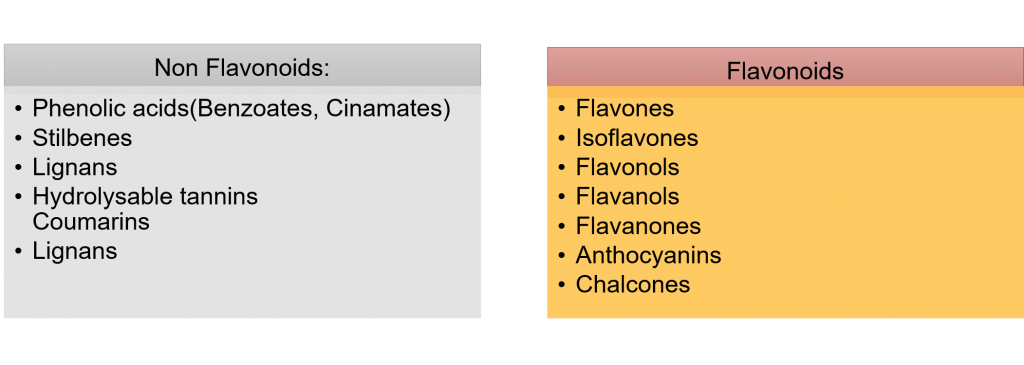By Alexandros Tzachristas and Charalampos Proestos *
Department of Chemistry, Food Chemistry Laboratory, School of Sciences, National and Kapodistrian University of Athens, 15784 Athens, Greece. *harpro@chem.uoa.gr
Overview
Polyphenols constitute a diverse group of bioactive compounds occurring in both grapes and wines. Polyphenols also exhibit a significant role in modern food technology and human nutrition and are frequently key ingredients in functional foods. The benefits derived from the moderated wine consumption for human health have been well elaborated with several groups of phenolic compounds including stilbenes, flavonols, and proanthocyanidins found to exert various health-promoting properties.
Wine production is regulated by OIV (International Organization of Vine and Wine), global wine policies, and national governments. Provision of authentic wines to the market has always been a prerequisite meaning that the declarations on the wine label should mirror the composition and provenance of this intriguing product. However multiple cases of intentional or unintentional wine mislabeling have been recorded, alarming wine consumers who demand for strict controls safeguarding wine transparency.
Wine is a complex matrix composed of molecules of diverse nature, significantly influenced by environmental factors, as well as viticultural and oenological management approaches. Concerning the latter, various winemaking practices are implemented that play a key role in the composition of the final product. As a result, wine fraud detection can become a challenging task. It has been reported that specific phenolic compounds can be employed as markers in authenticity verification.
Structural Information
From a structural aspect, polyphenols can be divided into two main categories, the flavonoids that bear a common C6-C3-C6 skeleton and the non-flavonoids (Fig. 1, 2).

Essentially non-flavonoid polyphenols are located in the grape pulp with the main classes comprising of phenolic acids and stilbenes as well as their derivatives. In wine, oak-derived non-flavonoids have also been detected including the classes of hydrolysable tannins (gallotannins and elagitannins), coumarins, and lignans.
Flavonoids are secondary metabolites occurring in a wide variety of natural products such as vegetables, fruits, stems, cocoa, tea, grapes, and wine. In wine, flavonoids have a fundamental role in the determination of its sensory attributes specifically wine color, flavor, astringency, and bitterness. Total phenolic content in red wine ranges from 1200 to 1800 mg gallic acid equivalents/L, which is six to nine times more than the corresponding content in white wines .

Among phenolics, anthocyanins are regarded as the most successful compounds for red wine varietal authentication. For instance, diglucoside anthocyanins displaying a second glyosidic bond at position 5′ with glucose characterize non-V. vinifera grapes and this has been successfully employed in chemotaxonomical studies. The relative proportion of acylated vs non-acylated anthocyanins is characteristic of each grape variety and has been proposed for cultivar differentiation; however, caution must be taken since these proportions can be modified during the vinification process with the use of pectolytic enzymes or specific maceration conditions.
Studies Focusing on Varietal or Geographical Origin Discrimination
Chemotaxonomical studies employing polyphenolic compounds mainly focus on (intra-, inter) varietal/geographical origin characterization, discrimination as well fraud detection. As the data provided by the analytical platforms do not often solely target polyphenolic compounds, in modern studies, polyphenolic substances are part of the compounds that contribute to class separation.
Several studies have been conducted worldwide contributing to wine authenticity assessment. Most recently, researchers provided the characterization of the metabolome of 11 single-cultivar, single-vintage Italian red wines with the use of untargeted HRMS metabolomics. In this significant study, among other biomarkers, quercetin was found more abundant in Sangiovese wines followed by Nebiolo and Nerello, isorhamnetin was more abundant in Nebiolo wines, while anthocyanin content was found higher in Teroldego wines. Other researchers also employing HRMS metabolomics proposed a method based on the calculation of secondary metabolite indexes namely (dihydro-)flavonols and anthocyanin ratios, to identify the unauthorized use of Primitivo and Negro Amaro grapes in the production of Valpolicella wines. They showed that the addition of Primitivo in the blend could be detected as it increased the indexes related to Laricitrin, Delphinidin, and Petunidin.
Reports on phenolic compounds mostly refer to red wines. However, polyphenolic compounds have also been found to contribute to rose’ or white wine classification. Researchers discriminated rosé wines using shotgun metabolomics with a genetic algorithm and MS ion intensity ratios. They focused on polyphenols and reported that the compounds used for discrimination were vanillic acid, peonidin 3-O-acetyl-Glucoside-(epi)catechin, peonidin 3-O-Glucoside, and (epi)catechin-ethyl-(epi)catechin isomers. Other works present applying untargeted metabolomics coupled to multivariate methods of analysis, investigated the phenolic composition of Chardonnay wines from different origins. Flavonoids and, in particular flavonols, were found to be the best markers in relation to geographical origin.
Novel polyphenolic compounds have also been found to contribute wine authenticity. For instance, researchers investigated the distribution of a novel crown hexameric procyanidin and its tetrameric and pentameric congeners in Italian red and white wines by means of HPLC-HRMS/MS. They reported the presence of a crown hexameric procyanidin only in the red wines examined, while crown tetramer and pentamer procyanidins were also present in white wines. The authors suggested that the proportions of crown 4-, 5-, and 6-mer procyanidins are grape variety dependent and demonstrated that crown procyanidins may act as a tool in wine authenticity studies.
Synergy between different analytical platforms or methods presents an increasing trend in wine authentication. In this direction, researchers applied online HILIC × RPLC separation coupled to high-resolution mass spectrometry and characterized in detail the anthocyanin and derived pigments content of one and six year old Pinotage wine. In another work, researchers performed a real case study on wine authentication, evaluating the complementarity of a q-NMR method with classical multidisciplinary approaches. The analyzed samples belonged to three categories (a) half bottled wines topped up with wine of different origin, (b) suspect wine samples from the foreign market, and (c) authentic samples. The authors demonstrated the synergy between the methods examined and phenolic compound were the compounds evaluated.
Conclusion
Polyphenols are a diverse group of compounds of utter importance to wine quality. Current understanding of the polyphenolic composition in wine is well elaborated, however, recent studies continuously report novel findings involving them. It is evident that synergistic approaches between emerging analytical platforms in combination with advanced multivariate data analysis will be considered the spearheads toward fraud detection and the provision of authentic wines.

Alexandros Tzachristas 
Charalampos Proestos 

Alexandros Tzachristas is a Phd Candidate in the Food Chemistry Department at the National an Kapodistrian University of Athens. His main research interests focus on wine metabolomics, as well as on vinifications without added sulphites. He also has 15 years of experience as a field oenologist as well as several years of experience in the implementation and auditing of Quality Management Systems in the Food industry.
Charalampos Proestos has a BSc in Chemistry, University of Ioannina, Greece and MSc in Food Science at Reading University, U.K. He obtained his Ph.D. in Food Chemistry at Agricultural University of Athens (AUA), Greece, where he continued his post doc working on natural antioxidants on programmes funded by EU and Greece. After further training at Wageningen University (The Netherlands), he worked as a Research Associate at AUA. He worked as a Chemist for the Hellenic Food Authority (EFET), being food industry auditor and supervisor of the Chemical laboratory in Athens accredited with ISO 17025. Currently he is Associate Professor at the Department of Chemistry, National and Kapodistrian University of Athens and director of the laboratory of Food Chemistry. He has published more than 70 papers in reputed journals. He is Member of the European Committee of the Division of Food Chemistry, European Association of Chemical and Molecular Sciences (EuChemS). His research field focuses on Food antioxidants, foodomics and food contaminants.


[…] Science & Wine: Polyphenols in Wine Authenticity […]